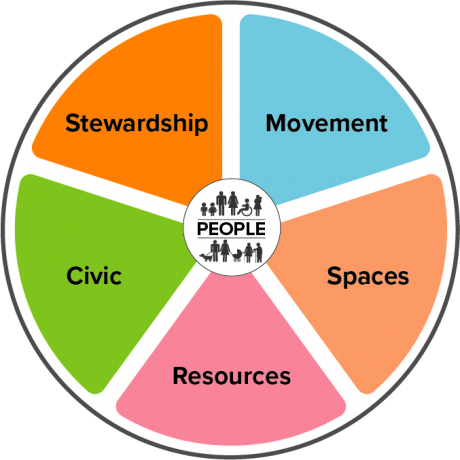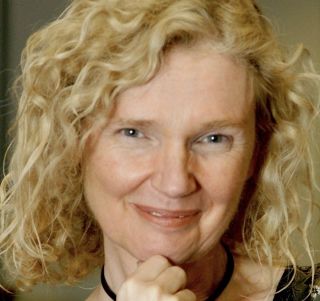Shaping our thinking... on people’s experiences of place and inequality.
Sharing our learning... on our process to understand this.
In this blog, Sarah Rodway Swanson, Community Link Lead for Alloa, explains how the Community Link Leads bring quantitative data on Project Towns to life, to help us understand what it means for people who live in these communities.
More information about the programme is at the end of this blog.
 The work of the Shaping Places for Wellbeing Programme is anchored in embedding the Place and Wellbeing Outcomes into decisions that impact the places where we live, work and relax. People are at the centre of the Outcomes - the Programme aims to ensure actions and decisions about a place are driven by an understanding of what everyone, particularly those experiencing inequality, in that community needs .
The work of the Shaping Places for Wellbeing Programme is anchored in embedding the Place and Wellbeing Outcomes into decisions that impact the places where we live, work and relax. People are at the centre of the Outcomes - the Programme aims to ensure actions and decisions about a place are driven by an understanding of what everyone, particularly those experiencing inequality, in that community needs .
As Alex Wilde, Dunoon Project Lead, explained in her earlier blog, we’re supporting data led decision making in each of our Project Towns. A comprehensive quantitative data profile developed with support from the Public Health Scotland Local Intelligence System Team (LIST ) was the starting point to understand the perspectives of the groups impacted by inequality and what they need from a place, and to support partners when making decisions that impact a place.
The next step was to bring the quantitative data to life to understand what this means for people who live, work and relax in our Project Towns, and their lived reality of the Place and Wellbeing Outcomes
Our approach
With a focus on the population groups highlighted by the quantitative data, a Community Link Lead in each town sense checked this data and gathered qualitative insight through two main avenues:
- Documents: we reviewed previous documents that reported qualitative data or formal community engagement in our Project Towns.
- Conversations: connecting with local groups, third sector organisations and practitioners generously shared their knowledge, experience and insight through conversations with the Community Link Lead.
We are sharing our findings through an infographic and report. These are not exhaustive representations of the topics raised, but those raised by multiple stakeholders across sectors which thus suggest a more collective, shared experience of a place by its residents.
What has the Community Link Leads’ work added to the programme?
In this blog we explain some of the ways we helped bring the quantitative data to life.
By creating a valuable qualitative dataset, the Community Link Leads have given us a deeper understanding of our community's needs. This role acts as a bridge between data and community insights, significantly enhancing our work. It ensures that our support to key contacts who lead on developing systems, strategies, and plans is not only impactful but also prioritises the needs of Alloa's key groups.
Quantitative data is not the whole story
A key task for the Community Link Leads has been to sense check the quantitative data – to confirm whether the numbers reflect how people experience and perceive these issues. Doing so has added context and strengthened the existing data profiles, adding important dimensions for decision makers to consider.
Our quantitative data tells us that the Carers Allowance case entitlement in Alloa South and East is significantly higher than Scotland, or in neighbouring areas of Alloa. Talking to a representative from the Carers Centre contextualised this data. Carers Allowance has strict eligibility criteria which may exclude many carers. Additionally, the Community Link Lead heard that often people do not identify themselves as carers – they provide care as an act of love, or familial duty, and so do not ask for support. This suggests that the level of unpaid caring is likely to be much higher than that initial quantitative data suggested. This conversation helped give us a fuller picture and understand whose experiences may be missing from the initial quantitative data.
Capturing aspects that don’t show up in quantitative data
Quantitative data may not be routinely collected, or may not be publicly available, on a range of issues. Limited availability of data does not necessarily mean absence of a problem. Conversations with local groups, organisations and practitioners identified additional inequality issues.
Mental health has emerged as a priority across most of our towns. Mental health interacts with other factors people are experiencing, like poverty, substance use and isolation. We have heard that poor mental health can be both a contributing factor to, and a consequence of, these inequalities.
Other aspects of place may simply not be captured by quantitative data – those parts that are about people’s subjective experiences.
We’ve heard that some communities have a strong sense of community spirit. ‘Identity and belonging’ is one of the Place and Wellbeing Outcomes. In Ayr, the Community Link Lead heard how a community wellbeing programme1 promotes community cohesion and belonging. Participants feel a sense of pride and purpose from the chance to volunteer, complete training and develop new skills in their community.
Shining a light on strengths
We are conscious of the potential for quantitative data to lead us to be rather deficit focused – highlighting the negative aspects of a place. The work of the Community Link Leads allows us to also understand the assets, capacities and capabilities that communities already have, like the sense of community in Ayr exemplified above.
Other assets include the services and support already provided in our Project Towns by local groups and organisations actively engaged in improving place and wellbeing. Across our Project Towns, Community Link Leads have heard that community stakeholders want to feel their expertise and delivery is more valued. They are seeking improved partnership and joint working opportunities.
The rate of alcohol related hospital admissions in Dunoon is 40% higher than the Scotland wide rate, and 63% higher than Argyll and Bute. This tells us that the community is impacted by substance use but doesn’t tell us anything about how people are managing or recovering from substance use. Community Link Lead research highlighted a new collaborative community-led Hub recently opened in a former post office on Dunoon’s High Street. The Hub brings together various local support organisations and includes a weekly addictions recovery café plus support and advice sessions from partners. Understanding the role of this local asset in supporting those experiencing the identified inequality, gives a richer picture of the place the Programme is working in as we all work towards prevention.
Understand what people need from their place
The work of the Community Link Leads built an understanding of what those most impacted by the identified inequalities in our Project Towns need so that they can experience the Place and Wellbeing Outcomes.
The Outcome ‘Play and Recreation’ under the ‘Spaces’ theme states that everyone should be able to access a range of high quality, safe, well-maintained, accessible places with opportunities for play and recreation to meet the varying needs of different population groups and the community itself. In Alloa, the Community Link Lead heard that negative stereotypes and division between neighbourhoods mean some children and families do not feel able to access certain parks and play equipment. Children experiencing poverty is a key inequality focus for the Programme in Alloa. We understand that whilst physical play equipment may be provided, work on community cohesion is needed to ensure everyone experiences the Outcomes.
Feed into Place and Wellbeing Assessments
Place and Wellbeing Assessments offer a structured process for decision makers to consider the impact of a strategy, plan or proposal on place and how much it enables the wellbeing of those using it. Each assessment produces a report recommending how a more place-based approach can be taken. Through the Community Link Leads, we have been able to contribute insights of lived reality of the people who live, work and play in our Project Towns to the assessments.
Place and Wellbeing assessments are an effective way of ensuring that place and wellbeing objectives are being built into our projects and strategies. However, we often carry out our work without asking for, or hearing, the lived experiences of the people we serve. This invaluable viewpoint can focus our minds on what really affects people's everyday lives and help us to produce work that makes a real difference in our communities.
During an assessment of the Dalkeith Regeneration Development Plan, the Community Link Lead shared what they had heard about the value of community transport in facilitating access to recreation and support services for older adults and people with reduced mobility. The resulting Place and Wellbeing Assessment Report recommends the team responsible for the Plan explore community transport options further and link with relevant organisations.
Next steps
Our experience has highlighted the importance of bringing both qualitative and quantitative information into our decision making process. The Programme has developed a set of ‘How To’ Guides which share our learning with anyone who wishes to replicate this within their own place-based work. Currently, you can find a guide on capturing quantitative data and on running a Place and Wellbeing Assessment. Following this blog, we intend to develop a guide to capturing the qualitative information too.
Ongoing support to deliver the Influence and Control outcome
Stewardship | Influence and Control | Everyone is empowered to be involved in a place in which:
|
Through the remainder of the programme there will be a focus on working with teams to deliver recommendations made. The Community Link Leads will support connection between decision makers and the communities they serve. Under the overarching Place and Wellbeing Outcomes theme of Stewardship sits the theme of ‘Influence and Control’.
The Community Link Leads are in a particularly strong position to build on the relationships they’ve already made and support teams following a Place and Wellbeing Assessment to improve delivery on this outcome.
Notes:
1. Vics Wellbeing Programme in Ayr. This programme is supported through VASA (Voluntary Action South Ayrshire) and funded from South Ayrshire HSCP Wellbeing Fund.
As part of the Shaping Places for Wellbeing Programme we aim to evaluate our work and share our learning across different key stages of the programme. One way we will share this is through the ‘Shaping our thinking, sharing our learning’ blog series.
Some key information about the programme:
- We are working to improve Scotland’s wellbeing by reducing the significant inequality in the health of its people while addressing the health of our planet.
- The action is anchored in the Place and Wellbeing Outcomes.
- It is a joint programme between the Improvement Service and Public Health Scotland working in local partnership with local authorities and local health boards.
- We have three key activities to support local activity:
- Local Project Towns support in Ayr, Alloa, Clydebank, Dunoon, Fraserburgh, Rutherglen and Dalkeith.
- Local Learning Cohort
- National Leadership Cohort
- It runs until March 2024.
If you are looking at place-based approaches, or if the Shaping Places for Wellbeing Programme sounds like something you would like to know more about, please contact Irene Beautyman, Place and Wellbeing Partnership Lead, below or follow us on X (Twitter) @place4wellbeing to keep up to date with all of our latest news

Irene Beautyman - Place and Wellbeing Partnership Lead
Phone: 07908 930763
-
Shaping Places for Wellbeing Programme
The Shaping Places for Wellbeing Programme is a joint delivery partnership between the Improvement Service and Public Health Scotland. This forum is for those interested in our work supporting the role of place to reduce inequality and improve the wellbeing of people and planet.
-
Place Network
For those interested in the importance of place as a working approach to delivering national outcomes around improved wellbeing and inclusive growth.